ELECTRICITY for Class 10 PHYSICS
INTRODUCTION
Hum sabhi apne daily life me all the time electricity use karte hai, humare gharo me, schools me, offices me and industries me etc. Yaha tak ki koi teacher bhi ager aapko online padha raha hai ya aap hi online class attain kr rahe ho to bina electricity ke ye possible nahi hai. Pr kya aap samjhte hai ki electricity hota kya hai? Wires me aisa kya magic hota hai joki lights, fans, computers and machines ko run karta hai. Electric circuit, electric current, electric charge and electric potential in terms ka mtlb kya hota hai? So don't worry, hum yaha pr bht hi easy way me in sare terms ko smjhenge.
Kya aap imagine kr sakte hai ki bina electricity ke aapki life kaisi hogi? Humari life puri electricity ke uper depend hai, kyunki humari basic jarurt ki sabhi chije jaise ki bulbs, iron, computer, train, washing machine, TV, mobile etc electricity se hi chalti hai. Isliye bina electricity ke humari life bht hi difficult ho jayegi.
What is Electricity? Electricity ek physical phenomenon hai jo electric charges ke presence ya flow ke karan hota hai. Ab aap soch rahe honge ki electric charge kya hota hai? Ise smjhne ke liye hume kisi atom ke atomic structure pe ana hoga. Kisi bhi atom me protons, electrons and neutrons present hote hai jaise niche fig me show kiya gaya hai. Protons and neutrons atom ke center me placed hote hai jise nucleous kahte hai, jabki electrons nucleous ke charo taraf move karte hai. Neutrons me koi charge nahi hota, protons positive charged hote hai and electrons negative charged hote hai. Atom ke outer layer me kuchh electrons free electrons hote hai joki ek atom se dusre atom me transfer bhi ho sakte hai. In transferable free electrons ko hi electric charge kahte hai. Electric charge ka sabse chhota element electron hai.

Types of Electricity - Electricity do types ke hote hai.
1. Static electricity
2. Current electricity
Static Electricity: Static electricity ka mtlb hai jab electric charge ruka hua hota hai (only present hota hai), flow nahi hota use hum static electricity kahte hai.
Current Electricity: Current electricity ka mtlb hai jab electric charge flow hota hai use current electricity kahte hai.
Electricity ka basic samjhne ke baad aap niche diye gaye figure me dekh sakte hai ki Electricity ke ander is chapter me hum koun-koun se points pe focus karenge.
1. Definition of Electricity -Physical phenomena associated with the presence and flow of electric charge is known as electricity.
ELECTRIC CURRENT AND CIRCUIT
Electric current ke terms ko samjhne se phle hume jarurt hai electric charge ko smjhne ki. Iske phle humne electric charge ke bare me basic discussion kiya, yaha hum ise or achche se samjhenge jiske liye humne niche diye figures me yaha pr kuchh examples liye hai. Jab hum kisi balloons ko apne hairs se rub karte hai to hairs balloons se chipkne lagte hai. Ager hum comb ko ya pen ko bhi hairs se rub karke dekhe or unhe papers ke tukdo ke pass le jaye to ye chipkne lagenge. Aisa isliye hota hai kyuki in objects ko hairs se rub karne ke karan unme friction hota hai or friction ke karan hi hairs ke free electron balloons me, comb me ya pen me transfer ho jate hai. Electrons negative charge hote hai jo hairs se in objects me transfer hone ke baad comb, pen ya balloon ko negatively charge kr dete hai (electron negative charge hone ke karan jaha jata hai use negative bana deta hai). Ab balloons hairs ko and comb/pen papers ke tukdo ko unme present positive charge ki wajah se apni taraf attract karta hai jiske karan ye aapas me chipkne lagte hai. Iske alawa ager hum kisi glass rod ko silk ke kapde se rub karte hai to rub karne se unke bich friction hua jiske karan glass rod ke free electrons silk cloth me transfer ho jate hai or inhe pass lane pr glass rod or silk aapas me chipakne lagte hai.

Is prakar electric charge mass ya length ki tarah hi ek fundamental property hai joki electrons, protons or dusre elementory particles ke aapas me jude hone ka karan hoti hai. Electric charge ke karan hi kisi atom me electrons or nucleus ke bich electric force act karta hai jo inhe aapas me bandh ke rakhta hai. Actual me nucleus proton or neutrons se milkr bana hota hai jisme protons positive charged hote hai jbki neutrons me koi charge nahi hota. Electric charge ko q se show kiya jata hai. Jiska SI unit coulombs (C) hota hai. Proton ka charge +1.6×10−19 C hota hai jabki electron ka charge −1.6×10−19 C hota hai or neutrons me zero charge hota hai.
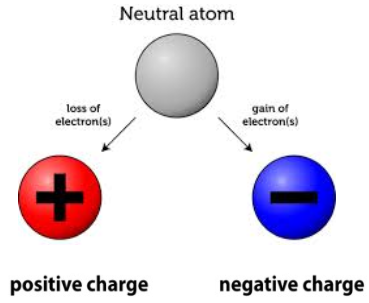
Ager kisi atom me no. of protons or electrons equal ho to atom, neutral atom kehlata hai (shown in above figure). Is neutral atoms se jab electron nikal kr dusre atom me jata hai to phle atom se electron nikala mtlb loss hua to phla atom joki neutral tha wo ab charged ho gaya wo bhi positive charged kyuki us atom se electron bahar nikla. Dusre atom jisme electron aya mtlb isne electron grahan kiya to dusra atom bhi jo phle neutral tha ab extra electrons aagaye to ye bhi charged ho gaya but negative charged atom ban gaya. (Electron negative charge hai, jaha bhi jata hai use negative charged bana deta hai)
Is tarah se charge do types ke hote hai. Ek positive charge or dusra negative charge. Jaisa ki humne padha ki kisi atom ke proton positive charged hote hai or electrons negative charged hote hai jo opposite charges hai. Opposite charges ek dusre ko attract karte hai jaise ki kisi atom me electron or proton ke bich attraction ya electric force inke opposite charged hone ke karan hi hoti hai (ek dusre ko pass khinchati hai). Opposite charges ko unlike charges bhi kahte hai. Ager charge same ho (positive-positive ya negative-negative) to unko like charges kahate hai or inke bich repulsion hota hai (ek dusre se dur hatati hai). Jaisa ki niche diye gaye figures me dikhaya gaya hai.
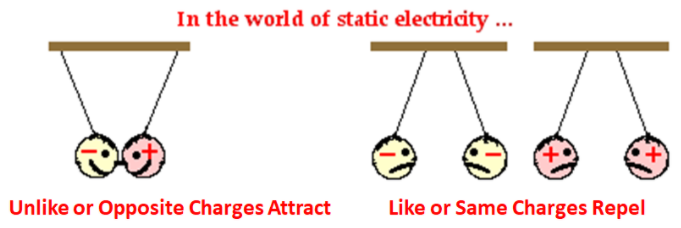
Ab tak humne jo bhi examples liye usme bodies ko rub karne ke karan free electrons transfer ho rae the or bodies charged ho ja ry thi. In bodies me ye charges ruke hue the. Jab charges body me ruke hue hote hai unhe hum static electricity kahte hai. Ye charges un bodies me rukte hai jo in charges ko apne me se flow nahi hone deti. Jo material apne me se charges ko flow nahi hone deti unhe hum insulator kahte hai. Plastic, wood, glass rubber, oil etc insulating materials hain.
Jab charges kisi body me rukti nahi hai balki flow ho jati hai, use hum current electricity kahte hai. Jo bodies apne me se charge ko flow hone k liye allow karti hai use hum conductors kahte hai. Copper, aluminium, silver, gold ek conducting materials hai.
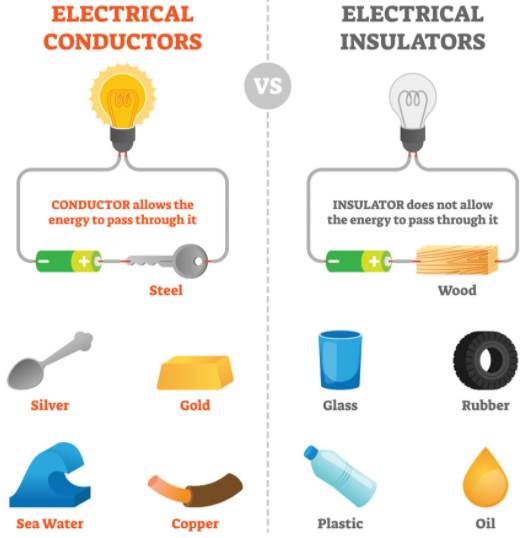
Electric Currents
Current electricity me jab electric charges kisi conductor se flow hote hai. Jab kisi conductor me net electric charge jis rate se flow hote hai, use electric current kahte hai.Electric current = the rate of flow of charge (rate of means kisi time pr jitna charge flow ho ya flow of charge (q) per unit time (t))
Electric current ko I se denote karte hai jiska SI unit ampere (A) hota hai.
Electric current = Electric charge/time
I=qt
Kisi metal wire me 1 sec me jitna charge flow hota hai utna electric current us metal wire se flow hua hai.
Electric current ki chhoti quantities milliampere mA or microampere μA hai.
1mA (milliampere) =11000=10−3A
1μA (microampere) =10−6A
Jaise niche figure me dikhaya gaya hai ek wire jisme electric current flow hota hai joki ek conducting material jaise copper ka bana hota hai. Is conducting material ko kisi insulating material jaise ki plastic se insulated karke wire ko protect kiya jata hai. Jisse ki current us wire ke ander hi flow ho taki hum ager us wire ko touch kare to hume current ke jhatke na lage. Ya ek wire se dusra wire touch ho to short circuit na ho jaye. (Short circuit ka mtlb hota hai ki ager do khule wires aapas me touch ho jaye to ek wire ka current dusre me flow ho jane ke karan wo jal jate hai, yahi short circuit kehlata hai.)

Ammeter
Electric current ko measure karne ke liye jis instrument ka use kiya jata hai, use ammeter kahte hai (shown in below figure). Ammeter ko kisi conductor ke series me (baju me hi ya side by side) hi connect kiya jata hai.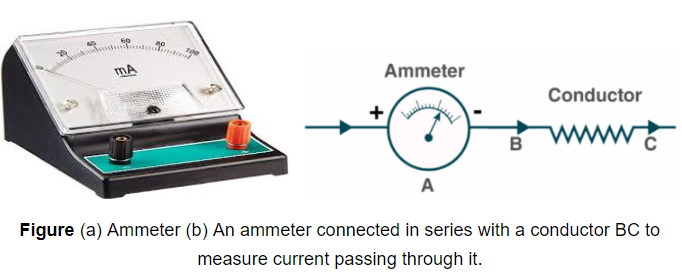
Direction of Electric Current
Electric current kaha se kaha flow hota hai? Jaise ki water flow hota hai to kisi height se niche ki taraf hi flow hota hai. Kisi slope me koi ball uper se niche ki taraf hi flow hota hai thk isi tarah current higher potential se lower potential ki taraf flow hota hai jaisa niche diye gaye figure me show kiya gaya hai. Ab ye potential kya hota hai? Ise hum next topic me discuss karenge.
Positive charges higher potential hote hai jabki negative charges lower potential hote hai isiliye electric current positive charge se negative charge ke direction me flow hoti hai. Electrons negatively charged elements hai jo positive charges se attract hote hai isliye electrons ka flow negative charge se positive charge ki taraf mtlb electric current ke opposite direction me hota hai.
Jab bahut pehle electricity ki khoj hui tab charges ke two types positive or negative charges ko hi jana jata tha. Us time pe electrons ki khoj nahi hui thi. Isliye electric current ko flow of positive charges mana gaya tha. Jab baad me electrons ki khoj hui to pata chala ki flow of charge free electrons (negative charges) ke karan hota hai naki positive charges means proton ke karan. But ager hum electric current ki direction me change karte to purane sare books and papers me electric current ki direction ko change karna padta joki possible nahi tha. Isliye electric current ki direction ko change na karke positive to negative end hi rakha gaya jise direction of conventional current kahate hai. Free electrons negative se positive flow hote hai inhe electronic current nam de diya gaya.
How the Current Flows in a Wire
Hum jante hai ki kisi metal wire me electrons ke flow ko hi electric current kahte hai jab wire ko kisi cell ya battery ke across connect kiya gaya ho. Metal wire me bht sare free electrons present hote hai. Jab kisi metal wire se koi cell ya battery wire ke across connect nahi hota tab ye free electrons randomly sabhi direction me move karte hai. Jaisa ki niche diye gaye figure me show kiya gaya hai.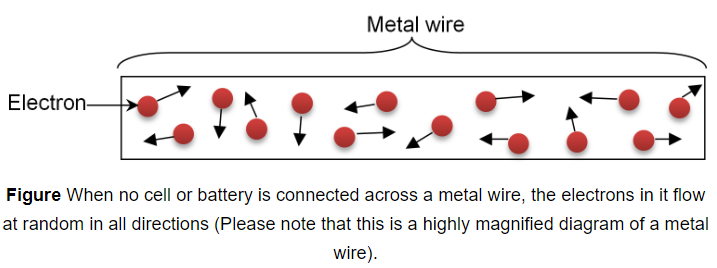
Jab metal wires ke dono ends me electricity ka koi source jaise ki cell ya battery connect kiya jaye to wire me present free electrons me koi electric force act karta hai. Kyuki electrons negative charged hote hai jo electric force ke karan in positive charges se attract ho kr negative end se positive end ki direction me flow hona start kr dete hai (shown in below figure). In electrons ke flow ke karan hi wire me current aya. Lekin electric current ke flow ka direction conventional direction me positive to negative end hota hai jaisa ki niche figure me aap dekh sakte hai.
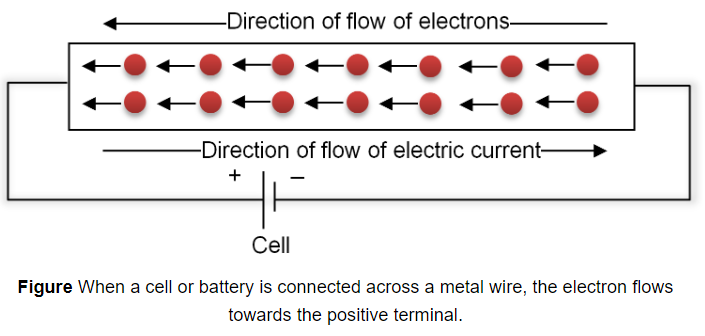
Continuous flow of electric current
Electric current ko kisi metal wire ya conductor se continuously flow karane ke liye wire ke dono ends ke bich unke potential me difference maintain kiya jaye to wire me continuously higher potential to lower potential current flow hota rahega.Ek single dry cell jo ki 1.5 V ka hota hai jisme do terminals hote hai (+positive terminal and -negative terminal) jaisa ki niche figure me show kiya gaya hai ager ise kisi electric bulb ke across connect kiya jaye to cell ke ander hone wale chemical reaction ki wajah se wire ke dono end me potential difference maintain rahega or continuously current flow hone ke karan bulb glow karta rahega.
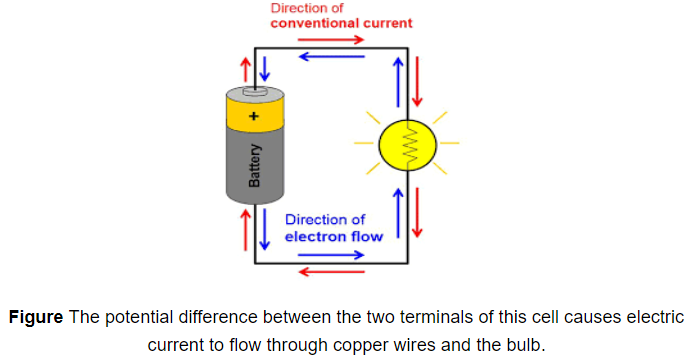
Electric Circuits
Electric current ya electrons ke flow hone ke liye humne koi elctricity ka source jaise ki cell ya battery ko kisi metal wire ya conductor ke across connect kiya. Is connections se hume electric current ke flow ke liye continuous conducting path mila jise hum electric circuit kahte hai. Niche diye gaye figure me simple electric circuit show kiya gaya hai jisme as a conducting wire copper material ka use kiya gaya hai jisme bulb ko glow karane ke liye use ek battery ke across conducting wire se connect kiya hai. Electric circuit me battery ke do terminal (positive and negative) hote hai jo electric force provide karte hai. Is electric force ke karan negative charged electrons battery ke opposite terminal ke positive charges se attract hoti hai or negative to positive end me move karti hai. Electric circuit me electrons ke flow ke karan electric current positive end se negative end me continuously conducting path me flow hota hai. Is conducting path me ek switch bhi laga hota hai jise path ko open ya close karne ke liye use kiya jata hai. Jaise ki aapke gharo me lights, fans ko on/off karne ke liye switch hoti hai.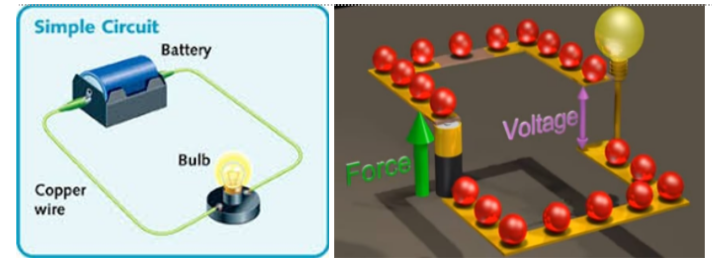
Types of electric circuits: Electric circuit two types ke hote hai.
1. Open electric circuit
2. Closed electric circuit
Open electric circuit : Jab kisi circuit me kisi point pr electric contact break ho jane se circuit me koi current flow nahi hota to use open electric circuit kahte hai.
Closed electric circuit : Jab kisi circuit me sabhi components ek dusre se join hote hai or continuously conducting path me current flow hota rhta hai, use closed electric circuit kahte hai.
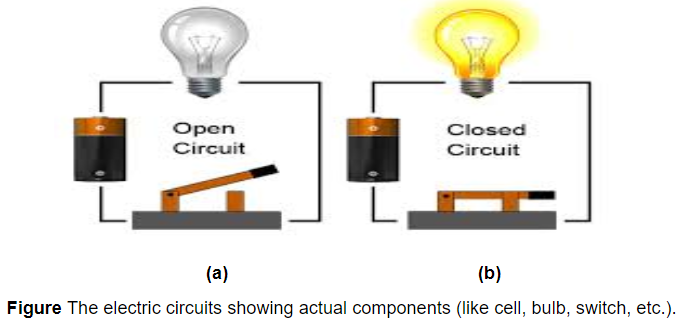
Uper dikhaye gaye figure me open electric circuit or closed electric circuit show kiya gaya hai. Jisme electric current ke path ko break karne ke liye switch laga hua hai. Jab switch ko open ya off kr dete hai to path me gap create ho jata hai or current ka path break ho jata hai jo open electric circuit hai. Path break hone se cell/battery bulb se disconnect ho jati hai or bulb glow nahi karta.
Jab switch ko close/on kr dete hai to circuit ka path complete ho jane se electric current flow hota hai or bulb glow karta hai, jo closed electric circuit hai.
Symbols for Electrical Components (or Circuit Symbols)
Kisi bhi electric circuit me various electrical components jaise ki cell, battery, connecting wires, wire joints, fixed resistance, variable resistance, ammeter, voltmeter, galvanometer, an open switch, a closed switch, and an electric bulb (or lamp), etc ko show karne ki jarurt hoti hai. Electric circuit ko draw karne ke liye in sahi components ko draw karna difficult or bahut time taking hota hai. Isliye in components ko electric circuit me inke electrical symbols ya circuit symbols se show kiya jata hai jo niche diye table me diya gaya hai. Isse complicated electric circuit draw karna easy ho jata hai.
POINT 1
1. Electric Charge :
Electric charge is a fundamental property like mass; length etc. associated with elementary particles for example electron, proton and many more.
or
Electric charge is the property responsible for electric forces which act between the nucleus and electron to bind the atom together.
2. Electric Current :
The electric current is a rate of flow of electric charges (called electrons) in a conductor such as a metal wire.
3. Electrical Conductor :
Substances through which electric charges can flow easily are called conductors.
4. Electrical Insulator :
Substances through which electric charges cannot flow are called insulators.
5. Electric Circuit :
A continuous conducting path consisting of wires and other resistances (like electric bulb, etc.) and a switch, between the two terminals of a cell or a battery along which an electric current flows, is called a electric circuit.
6. Open Electric Circuit :
It is the circuit in which electric contact is broken at some point such that no current flows through the components of the circuit.
7. Closed Electric Circuit :
The circuit in which all the components of a circuit are joined to one another such that a continuous current flows through them is a closed electric circuit.
8. Ammeter :
Current is measured by an instrument called ammeter.
EXAMPLE 1
What does an electric circuit mean ?
A continuous and closed consists of electric devices, source of electricity and wires that are connected with the help of a swich.
EXAMPLE 2
What do the following symbols represent in a circuit ? Write the name and one function of each ? [CBSE 2011, 2012, 2013, 2015]

(i) It represents a closed plug key. It is used to make the closed electric circuit.
(ii) It represents a variable resistance. It is used to increase or decrease the electric current in the circuit.
(iii) It represents a voltmeter. It is used to measure the potential difference across a resistor in the circuit.
(iv) It represents a galvanometer. It is used to detect the presence of small current in the circuit.
(v) It represents wire crossing (not connected with each other). The wires are used to connect various components in the circuit.
EXAMPLE 3
What is an electric circuit ? Distinguish between an open and a closed circuit. [CBSE (All India) 2009, 2010, 2011]
Electric circuit :
An electric circuit is a closed conducting path containing a source of electric energy (i.e., a cell or a battery) and a device or element or load (say, an electric bulb) utilizing the electric energy.
The direction of electric current is opposite to the direction of the flow of electrons in the conductor.
Open electric circuit : An electric circuit through which no electric current flows is known as open electric circuit.
The electric circuit shown in figure 10 (A) will be an open circuit if the plug of the key is taken out or if the connecting wire breaks from any point.
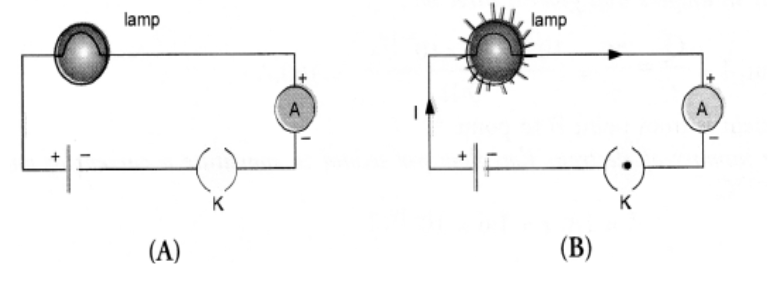
Closed circuit : An electric circuit through which electric current flows continuously is known as closed circuit (Figure (B)).
EXAMPLE 4
Mention the condition under which charge can move in a conductor. Name the device which is used to maintain this condition in an electric circuit. (CBSE 2012, 2013)
The ends of the conductor must be maintained at different voltages. This condition is maintained in a conductor by a cell or a battery.
EXAMPLE 5
Calculate the number of electrons constituting one coulomb of charge.
We know that the chare of an electron is 1.6×10−19 coulomb (or 1.6×10−19C). Now, if charge is 1.6×10−19C, No. of electrons = 1
So, If charge is 1C, then No. of electrons =11.6×10−19×1
=10191.6
=1016×1018
=6.25×1018
Thus, 6.25×1018 electrons taken together constitute 1 coulomb of charge.
The above example tells us that the SI unit of electric charge 'coulomb' (C) is equivalent to the charge contained in 6.25×1018 electrons. Thus, coulomb is a very big unit of electric charge.
ELECTRIC POTENTIAL AND POTENTIAL DIFFERENCE
Electric Potential
Ab tak humne samjha ki electric current, move hota hai electric charge ke karan but is electric charge ko koun move karta hai? Jab hum electric circuit me cell ya battery as a source lagate hai tab ye circuit me electric force ya pressure provide karte hai jiske karan charge move karte hai. Ye electric force tabhi provide ho sakta hai jab battery ke dono terminals ke bich potential difference present ho. Is potential difference ke liye jo general terms electric potential or voltage or electric potential difference or potential difference hai, in sabka mtlb ek hi hai jise cell/battery provide krta hai. To ager potential difference nahi hua to circuit me koi electric current bhi nahi hoga. Isliye electric potential ya electric voltage electric charge ko move karne ke liye ya current ke flow ke liye bht important concept hai?

Kya hai electric potential? Let’s understand it. Aapne potential energy ya potential at a height jaise terms ke bare me suna hoga ye sabhi electric potential ke similar hi sound ho rahe hai. Jab koi ball ko aap kisi height me rakhte hai to jitni jyada height hogi utna jyada potential energy us ball me hoga. Ye ball high potential energy se low potential energy tk move karti hai. To apko pta hoga ki ball ke motion ke liye high potential se low potential ki jarurat hai. Mtlb humare paas yaha pr potential difference hai. Ball ke motion ke liye potential difference ki jarurat hai. Isi tarah water ke flow ke liye slope ki jarurt hoti hai jisse ki water high potential to low potential flow hota hai. Similarly electricity me electric potential hota hai jo charge ko flow karane ke liye jaruri hota hai. Electric potential basically electric pressure ke jaisa hota hai. Electrons ko move karane ke liye aur flow of charge ke liye kuchh electric potential ki jarurt hoti hai. Jaise ki aap jante hai ki jab battery khatam ho jati hai to torch ka bulb jalna band ho jata hai. Battery khatam ho jane ka mtlb yahi hai ki battery ke terminals ke bich potential difference zero ho jata hai. Electric potential is just like electric pressure jaise ki jab aapka exam bht paas agya ho to aapko study karne ka bht pressure hota hai ya fr jab aapko kisi homework ko khatam karne ke liye deadline diya gaya ho to pressure ki wajah se aapka syllabus or homework jaldi se khatam ho jata hai. Isi tarah electric pressure electrons ko move karne ke liye push karta hai, pressure deta hai jab ye pressure nahi hota to electrons randomly kisi bhi direction me move karte hai but electric pressure ki wajah se electron particular direction me move kr pate hai or electric charge ke flow ke karan electric current flow ho pata hai.
Electric potential ko ager define kare to kisi electric field me per unit charge ko move karne ke liye jo work karna padta hai use electric potential kahte hai.
Example ke liye jab electric circuit me kisi bulb ke across battery lagate hai to electric force electrons ko negative end to positive end move karata hai jiske liye kuchh work karna padta hai. Ek unit charge ko move karane ke liye jitna work karna padega wahi uska electric potential hoga. Yaha pr battery ke dwara work done kiya jata hai ya charges ko circuit me push kiya jata hai. Ek normal cell jo market me milta hai wo 1.5 V ka hota hai. Battery ka mtlb jab ek se jyada cell ko connect kiya jata hai to use battery kahate hai. Ager aapke paas ghar me cell ho to use jarur check kare.
Electric potential ko V se denote karte hai or iska unit joule per coulomb or SI unit volt (V) hota hai.
1 volt potential ka mtlb 1 C charge ko move karane ke liye jab ek joule ka work done hota hai.
Potential Difference
Electric potential me difference ka mtlb kisi do point ke bich un do points ke potential me difference hota hai. Is prakar, kisi circuit me do point ke bich kisi unit charge ko ek point se dusre point tk lejane me kiya gaya work potential difference kehlata hai. Niche diye gaye figure me potential difference show kiya gaya hai.
Potential Difference = work done/quantity of charge transferred =WQ
Potential difference ka SI unit volt (V) hota hai.
Hum 1 volt potential difference ko define kr sakte hai. Jab 1C charge ko ek point se kisi dusre point tk move karane ke liye 1 joule ka work karna ho to potential difference 1 volt hota hai.
1 Volt= 1 joule/1Coulomb
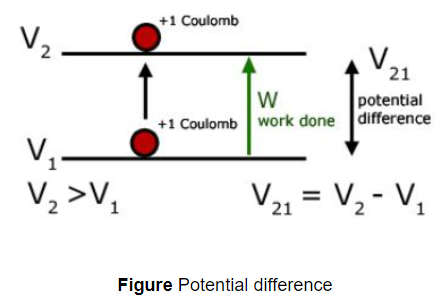
Voltmeter
Electric potential, potential difference ya electric voltage ko measure karne ke liye jis instrument ka use kiya jata hai use voltmeter kahte hai. Voltmeter ko jis me element ya equipment ka potential measure karna ho uske parallel me connect kiya jata hai kyuki potential difference kisi do points ke bich ka find karna hota hai. Niche figure me voltmeter or connection of voltmeter to conductor show kiya gaya hai.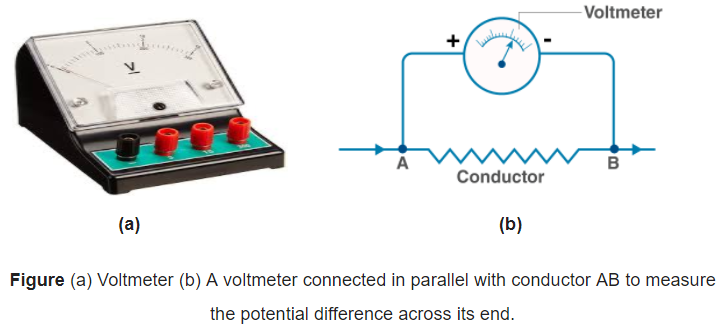
POINT 2
1. Electric Potential :
The electric potential (or potential) at a point in an electric field is defined as the work done in moving a unit positive charge from infinity to that point.
2. Potential Difference :
The potential difference between two points in an electric circuit is defined as the amount of work done in moving a unit charge from one point to the other point.
or
When we need to move the charge between two specified points, then the work done in doing so is called the potential difference. So,
Potential Difference = work done/quantity of charge transferred =WQ
The SI unit of electric potential difference is volt (V)
3. 1 Volt :
The Potential difference is said to be 1 volt when 1J of work is done in moving 1 C of charge from one point to another.
1 Volt= 1 joule/1Coulomb
4. Voltmeter :
The instrument that is used to measure magnitude of electric potential or potential difference is called Voltmeter.
CIRCUIT DIAGRAM
Electric circuits jisme sare elements ko show karne ke liye circuit diagram karke represent kiya jata hai.
Electric circuit me connected different components ko show karne ke liye electric symbols ka use karke ek diagram draw kiya jata hai, use circuit diagram kahte hai.
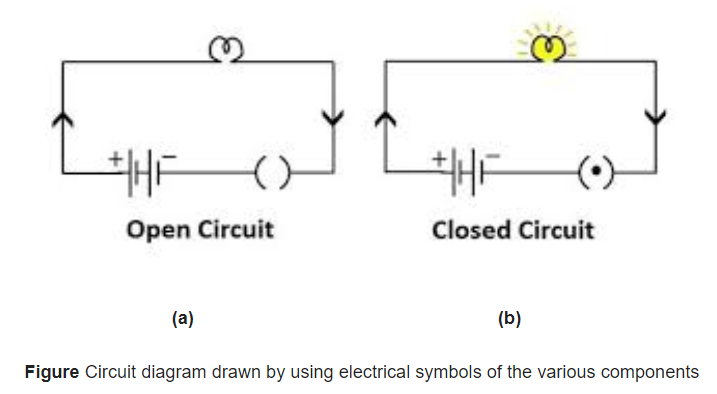
Uper diye gaye figure me aap circuit diagram dekh sakte hai ki battery jisme do cells use kiya gaya hai jisme + and - sign hai. Positive sign higher potential aur negative sign lower potential ko show karta hai. Different components ko connect karne ke liye line dikh rahi hai, ye conducting wire hai jo current ko easily flow hone deta hai. Circuit ke bich me jo gap hai wo show kr raha hai ki switch open/off hai jo open circuit hai. Jab circuit me koi gap nahi hota path complete hota hai iska mtlb hai switch close/on hai aur circuit closed circuit hai. Is circuit diagram me ek bulb bhi connected hai. Jab switch on karte hai to circuit me current flow hota hai aur bulb glow karta hai. Switch off karne pr circuit me current flow nahi hota aur bulb glow nahi karta. Ye circuit diagram electric circuit me use kiye gaye diagram ka simplified diagram hai.
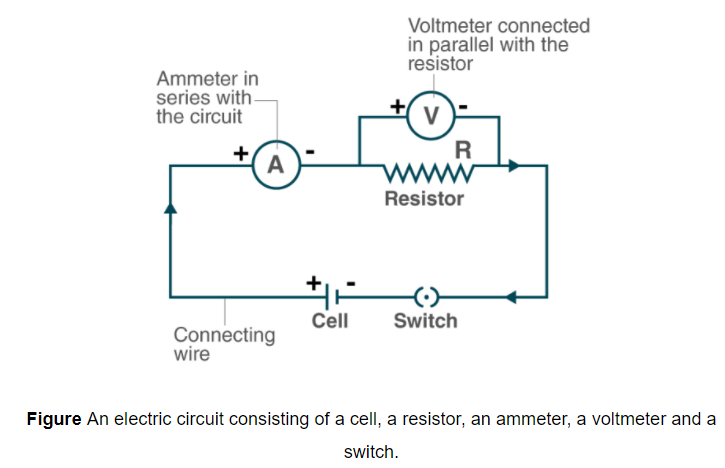
Uper diye gaye diagram me humne ek aur circuit diagram liya hai jisme kuchh extra components jaise ki ammeter, volmeter and resistor connect kiya hai. Resistor R ko cell ke two terminal se connect kiye hai aur isse flow hone wale electric current ko measure karne ke liye ammeter ko resistor ke series me connect kiya hai. Ammeter ko series me isliye connect kiya jata hai kyuki ammeter ke ander bhi uska internal resistance hota hai or ye resistance bht hi low hota hai. Isliye ammeter ko series me connect karne pr isme se flow hone wala current main resistor se flow hone wale current ke equal hota hai mtlb ammeter ka internal resistance bht hi low hone ke karan iska koi jyada effect nahi hota. Ager ammeter ko circuit ke parallal connect kiya jaye to iska internal resistance bht hi jyada km hone ke karan jab isme se current flow hoga to ammeter damage ho jaega isliye ammeter ko humesha series me hi connect kiya jata hai.
Resistor ke dono terminal ke bich potential difference ko measure karne ke liye voltmeter connect kiya hai. Voltmeter humesha parallel me connect karte hai kyuki hum resistor ke dono terminal ke bich potential measure karna hai. Iske alawa voltmeter ka internal resistance bht hi jyada high hone ke karan isme se negligible current flow hoga aur resistor ke across potential constant bana rahta hai. Ager voltmeter ko series me connect kiya jaye to high internal resistance ke karan jab isme se current flow hoga to bht jyada heated ho jayega. Yahi karan hai ki ammeter series me aur volmeter parallel me connect kiya jata hai.
POINT 3
1. Circuit Diagram :
Electrical circuits are represented by drawing circuit diagrams. A diagram which indicates how different components in a circuit have been connected by using the electrical symbols for the components, is called a circuit diagram.
EXAMPLE 6
How much work is done in moving a charge of 2 C across two points having a potential difference 12 V?
The amount of charge Q, that flows between two points at potential difference V (= 12 V) is 2 C.
Thus, the amount of work W, done in moving the charge is
W=VQ
=12V×2C
=24J.
OHM’S LAW
Ohm’s law ko samjhne ke liye kya aap George Ohm jaise scientist banne ke liye ready hai. Hum yaha ohm’s law ke concept ko samjhne ke liye ek simple experiment dekhenge. Hum yaha pr resistance ke concept ki baat karenge. Resistance word ka meaning hota hai oppose karna. Jaise ki chhuttiyo ke din aap morning jaldi uthana resist karenge ya fr study karne ka bhi resist karenge. Isi tarah kya aap jante hai ki wire me bhi resistance hota hai jo electric current ke flow ka oppose karta hai. Ohm’s law electricity me ek bht hi important law hai. Ohm’s law electric current aur electric potential difference ke bich relation deta hai. Electric current rate of flow of electric charge hai jiska unit ampere hota hai. Electric circuit me do point ke bich unit charge ko ek point se dusre point tk move karne ke liye jo work karna padta hai use potential difference kahte hai. Ise voltage bhi kahte hai or iska unit volt (V) hota hai.
Ab niche diye gaye figure me aap circuit arrangements dekh sakte hai. Circuit me battery (B) ke liye 1.5 V ki 4 cell lagi hui hai. Circuit me sare components conducting wire se connected hai jisme jise ek resistance wire lagi hui hai jo nichrome material ka hai. Ammeter, conducting wire se series me connected hai jo electric current ke measurement ke liye use karte hai. Nichrome wire ke across voltmeter laga hua hai jo is resistance se parallel me connected hai jo wire ke dono ends ke across voltage measure karta hai.

Hum apne experiment me supply voltage ko change karke nichrome wire ke across voltage ko change karenge. Voltage ke is change ko niche table me show kiya gaya hai.
Ab ager aap switch on karenge to starting me voltmeter 0 V show karega aur ammeter bhi 0 A current show karega. Iska mtlb hai ki current flow hone ke liye wire dono ends k bich kuchh n kuchh potential difference hona jaruri hai.
Ab dheere-dheere supply voltage badhate jayenge to voltmeter me bhi voltage ki reading show karega. Ager hum supply voltage 2 V rakhte hai to voltmeter me 1.2 V voltage and ammeter ka current 0.03 A show karta hai. Ager hum supply voltage 3 V rakhte hai to voltmeter me 3.6 V voltage and ammeter ka current 0.10 A show karta hai. Ager hum supply voltage 4 V karte hai to voltmeter me 6 V voltage and ammeter ka current 0.18 A show karta hai. Ab ager hum supply voltage 5 V karte hai to voltmeter me 8.4 V voltage and ammeter ka current 0.24 A show karta hai. In sabhi readings ko hum ek table me note karke observe karte hai ki jaise-jaise voltmeter ki reading increase hoti hai sath hi sath current ki reading bhi increase hote jati hai.
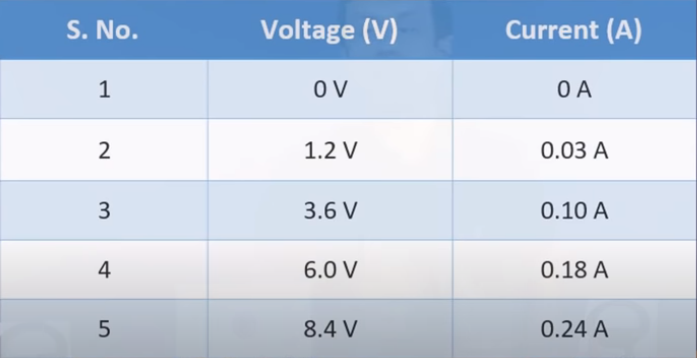
Ab hum is table ka graph plot karenge jo current aur potential difference ke bich ka graph hai (shown in below figure). Potential difference ko x-axis me or current ko y-axis me lete hai. Ab aap dekh sakte hai ki jo hume graph mila hai wo origin se paas hota hua approximate straight line hai. Straight line graph se hum conclude kr sakte hai ki current directly proportional hai potential difference ke. Isme humne ek condition bhi add kiya hai ki temperature constant hona chaiye.
Ohm’s law - Kisi constant temperature ke liye kisi conductor se flow hone wala current us conductor ke dono ends ke bich potential difference ke directly proportional hota hai.
Mathematically hum is tarah se likh sakte hai - current ∝ potential difference
I∝V
Directly proportional relation ka mtlb hota hai ager voltage double hoga to current bhi double hoga or ager voltage half hoga to current bhi half hoga. Voltage aur current same proportion me change ho raha hai.
Hum is relation ko reverse bhi kr sakte hai or ise likh sakte hai.
V∝I
Kisi conductor ke across potential difference directly proportional hai us conductor se flow hone wale current ke.
Hum is relation ko reverse kyu kr skte hai ? Ise samjhne ke liye hum simple example lete hai ki ager hum market me apple lene jate hai to hum jitne apple lenge utne apple ke paise dene padhenge. Yaha apple directly propotional hai money ke. Jitne jyada apple lenge utne jyada paise dene padhenge. Ager hum ise reverse kr de ki hum jitne paise denge utne paise ke apple hume milenge. Yaha pr money directly proportional hai apple ke. Jitne jyada paise denge utne jyada apple hume milenge. So we can reverse the relation.
Isi tarah V and I pr wapas aate hai. V∝I hum is proportional relation ko equation me bhi change kr sakte hai ek proportionality constant lagakr.
Equation ho jayega -
V=RI
Constant R ko hum conductor ka resistance kahte hai.
Resistance of a conductor

Ohm’s law se resistance ko define kr sakte hai.
Ager hum equation ko is tarah likhe
R=VI
To hum define kr sakte hai ki conductor ke across potential difference aur conductor se flow hone wale current ka ratio resistance kehlata hai.
Is formula ke base pr resistance ka SI unit V/A hoga ise hum ohms (Ω) kahte hai.
Hum apne experiment table ke resistance ko calculate karne ke liye voltage or current ka ratio find karke kr sakte hai. Aap niche table me dekhenge ki wire ke across resistance approximately 35 Ω hai. Isliye voltage or current ka ratio constant hota hai.
Voltage/Current = Constant
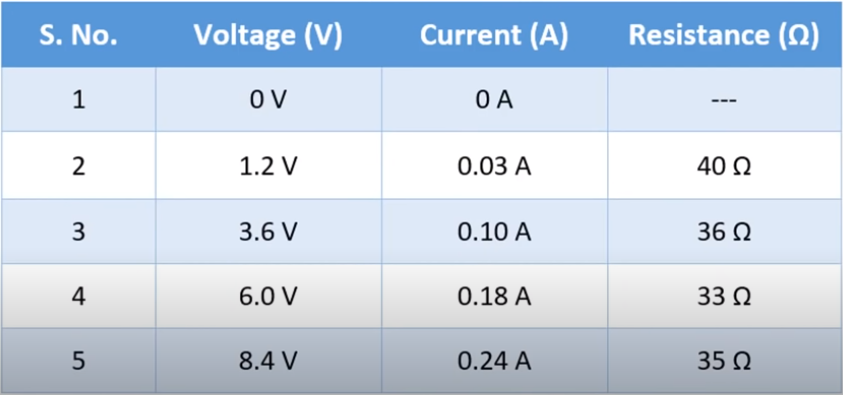
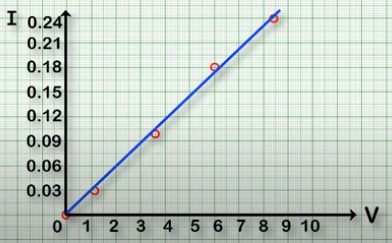
Aap resistance ki value ko directly graph se bhi nikal sakte ho. Graph hume straight line mila hai joki ek slope hai.
Slope = Change in y-axis/Change in x-axis =I/V
R=V/I = 1/slope
Voltage/Current = Constant ko hum Resistance word hi kyu use karte hai? Kyuki jaise jaise resistance ki value badhaya jaye vaise current ki value km hoti jati hai. Iska mtlb hai kisi conductor ka resistance usme se flow hone wale current ko rokta hai resist karta hai. Isliye constant ko resistance word se define kiya gaya.
Niche diye gaye figure me aap dekh sakte hai ki V, I and R ke relation ko hum different way me likh sakte hai.
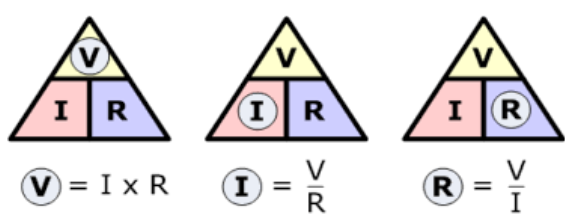
POINT 4
1. Ohm’s Law :
Ohm’s law gives a relationship between current and potential difference.
According to it, at a constant temperature, the current flowing through the circuit is directly proportional to the potential difference applied across the ends of the conductor.
2. Resistance of a conductor :
The property of a conductor due to which it opposes the flow of current through it is called resistance.
The SI unit of resistance is ohm which is denoted by the symbol omega Ω.
3. 1 Ohm :
resistance is said to be 1 ohm when 1 volt of potential difference is applied which allows 1 ampere current to flow through it.
4. Rheostat :
It is defined as the variable resistance. It is connected to change the current in the circuit without changing the voltage source like cell etc.
5. Galvanometer :
It is a device used to measure a very small amount of current as it has very low resistance.
EXAMPLE 7
(a) How much current will an electric bulb draw from a 220 V source, if the resistance of the bulb filament is 1200 Ω? (b) How much current will an electric heater coil draw from a 220 V source, if the resistance of the heater coil is 100 Ω?
(a) We are given V = 220 V;
R = 1200 Ω.
we have the current
I=220V1200Ω=0.18A
(b) We are given, V = 220 V, R = 100 Ω
we have the current
I=220V100Ω=2.2A
Note the difference of current drawn by an electric bulb and electric heater from the same 220 V source.
EXAMPLE 8
The potential difference between the terminals of an electric heater is 60 V when it draws a current of 4 A from the source. What current will the heater draw if the potential difference is increased to 120 V?
We are given, potential difference V = 60 V,
current I = 4 A
According to Ohm’s law,
R=VI=60V4A==15Ω
When the potential difference is increased to 120 V the current is given by
current =VR=120V15Ω=8A
The current through the heater becomes 8 A.
EXAMPLE 9
What are the advantages of connecting electrical divices in parallel with the battery instead of connecting them in series ?
There is no division of voltage among the appliances when connected in parallel. The potential difference across each appliance is equal to the supplied voltage. The total effective resistance of the crcuit can be reduced by connecting electrical appliances in parallel.
EXAMPLE 10
What determines the rate at which energy is deliverd by a current ?
The rate of consumption of electric energy in an electric appliance in called electric power. Hence, the rate at which energy is delivered by a current is the power of the appliance.
FACTORS ON WHICH THE RESISTANCE OF A CONDUCTOR DEPENDS
Kisi bhi conducting wire jaise copper or aluminium me resistance kyu hota hai? Jaise ki conducting copper wire ki baat kare to wire ke ander millions of copper atoms contain karke rakhta hai. Copper atom ka outer most electron apne nucleous se loosly bound hone ke karan apne atom ko chhodker wire me freely move karte hai isliye inhe free electrons bolte hai. Kyuki copper atoms apne electrons ko loose kar deta hai isliye wo copper ions ban jata hai. Ab wires me do chije ho gai, bht sare free electrons or copper ions. Ab ager is wire ke dono ends ke across potential apply kare to ye free electrons ek specific direction me move karenge. Kisi specific direction me free electrons ka motion electric current hai. Kyuki copper wire me large no. of free electrons hote hai isliye ye electricity ka good conductor hai. Ye wire solid hai jo free electrons ke sath sath bht sare copper ion bhi contain karke rakhta hai. Jab free electrons specific direction me move karte hai to ye copper ions ko hit karte hai ya copper ions ke against collide hote hai. Is tarah se wire me present copper ions electric current ke flow ko resist kr rae hai. Is prakar wire ka material resistance ka karan hota hai aur koi bhi substance ya material usme se flow hone wale current ko resist karta hai. Kyuki copper electricity ka good conductor hai isliye iska resistance low hota hai. Ager aap conducting wire ka material change karte hai to uska resistance bhi change ho jata hai.
Is prakar kisi bhi conductors ka resistance various factors pe depend karta hai jaise ki- Nature of material, Length, Thickness, Temperature of the conductor
1. Dependence of resistance on length of wire : Kisi wire ka resistance us wire ke length ke directly proportional hota hai. Wire ka length jitna jyada increase karenge electrons me collisions utna hi jyada badhne se wire ka resistance bhi increase hoga.
R∝l
2. Resistance on area of wire : Kisi wire ka resistance us wire ke cross sectional area ke inversely proportional hota hai. Wire ka area jitna jyada increase karenge electrons me collisions utna hi km hoga kyuki free electrons ko jyada space mil jayega jisse wire ka resistance decrease hoga.
R∝1A
3. Resistance on nature of wire: Kisi wire ka resistance us wire ke material pr depend karta hai, iske baare me humne uper detail me discuss kiya hai. Kuchh material me resistance low aur kuch material me resistance high hota hai.
For example, ager hum koi do material ka wire le aur unka length aur area same ho jaise ki copper metal and nichrome alloy, we will find that the resistance of the nichrome wire is about 60 times more than that of the copper wire. Ye show kata hai ki resistance kis material se bana hai is baat pr bhi depend karta hai.
4. Resistance on temperature : jab hum kisi circuit me temperature badhae to usme jyada heat develope hone lagta hai aur km karne se km heat develope hota hai iska mtlb hai ki resistance temperature bhi depend karega. But the resistance of alloys jaise ki manganin, constantan and nichrome ye aise material hai ki inse bane resistance temperature se lagbhag unaffected hi rahte hai.
Combining all factors we get :
R∝LA
R=ρLA
Specific Resistance or Resistivity
resistance ke sare factors ko combine karke R=ρL/A ye equation jo hume mila isme proportionality ko hatane ke liye ρ proportionality constant humne use kiya jise hum Resistivity ya specific resistance kahte hai.
Specific resistance, resistance ki wo value hai jo unit length aur unit area ke wire ke liye hota hai.
ρ=RAl
Resistivity ka SIunit Ω−m hota hai.
Specific resistance ya resistivity kisi conductor ke material ki property hai jo nature of the material and temperature pr depend karti hai.
Materials ki resistivity ager 10−8Ωm se 10−6Ωm ke range me ho to hum consider karte hai ki wo very good conductors hai. Silver ki resistivity equal to 1.60×10−8Ωm and copper ki resistivity equal to 1.62×10−8Ωm. hoti hai ye bht hi achche conductors hai but silver bht costly hone ke karan hum mostly copper conductors hi use karte hai.
Rubber and glass very good insulators hai. Kyuki inki resistivity 1012Ωmse1017Ωm ke bich hoti hai. Isliye ye more resistance create karte hai aur current ke flow ka oppose karte hai.
Niche table me aap different materials ke liye different resistivity dekh sakte hai.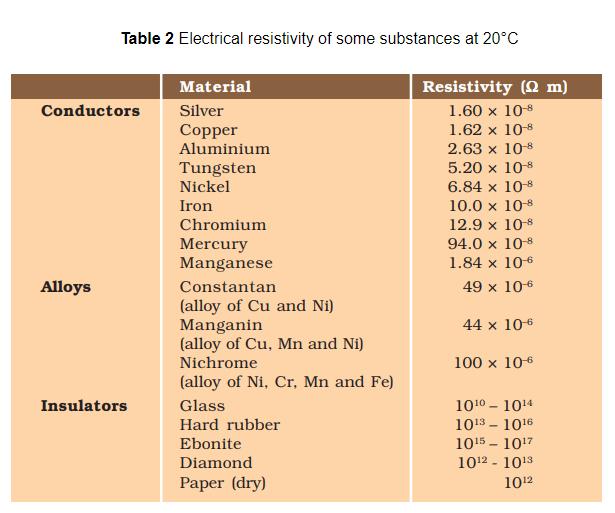
POINT 5
1. Specific Resistance or Resistivity :
Specific resistance or resistivity (ρ), of a conductor, is defined as the resistance of a conductor of unit length and unit area of cross-section.
ρ=RAl
SI unit of resistivity (ρ) is Ωm.
EXAMPLE 11
Resistance of a metal wire of length 1 m is 26 Ω at 20°C. If the diameter of the wire is 0.3 mm, what will be the resistivity of the metal at that temperature? Using Table 2, predict the material of the wire.
We are given the resistance R of the wire = 26 Ω,
the diameter d = 0.3 mm =3×10−4m,
and the length l of the wire = 1 m.
Therefore, the resistivity of the given metallic wire is
ρ=(RAl)=(Rπd24l)
Substitution of values in this gives
ρ=1.84×10–6Ωm
The resistivity of the metal at 20°C is 1.84×10–6Ωm
From Table 2, we see that this is the resistivity of manganese.
EXAMPLE 12
A wire of given material having length l and area of cross-section A has a resistance of 4 Ω. What would be the resistance of another wire of the same material having length l/2 and area of cross-section 2A?
For first wire R1=ρlA=4Ω
Now for second wire
R2=ρl22A=14ρlA
R2=14R1
R2=1Ω
The resistance of the new wire is 1Ω.
EXAMPLE 13
What is (a) the highest, (b) the lowest total resistance that can be secure by combinations of four coils of resistance 4Ω,8Ω,12Ω,24Ω ?
There are four of resistances 4Ω,8Ω,12Ωand 24Ω respectively.
(a) If these coils are connected in series, then the equivalent resistance will be the highest, given by sum 4+8+12+24=Ωrespectively.
(a) If these coils are connected in series. then equivalent resistance will be the highest, given by the sum 4+8+12+24=48Ω
(b) If these coils are connected in parallel, then the equivalent resistance will be the lowest, given by
114+18+112+124=16+3+2+124=2412=2Ω
Therefore, 2Ω is the lowest total resistance.
EXAMPLE 14
Two wires, one of copper and other of manganin, have equal lengths and equal resistances. Which wire is thicker ? Given that the resistivity of copper is lower than that of manganin. (CBSE 2011, 2015)
Resistance of a conductor is given by: R=ρlA or R=ρlA
At constant temperature, the resistance of a conductor depends on the following factors:
Length: The resistance R of a conductor is directly proportional to its length i.e.,
R∝l
Area of cross-section: The resistance R of a uniform conductor is inversely proportional to its area of cross-section A, i.e.,
R∝1A
Nature of material: The resistance of a conductor also depends on the nature of the material it is made of.
Combining all the above expressions, we get:
R=ρlA
where ρ is the constant of proportionality known as resistivity or specific resistance of the material of the conductor.
Now, it is given that the length of both conductors is the same. So the resistance must be kept the same by altering the area of the cross-section only because resistivity is a material-specific property.
Let ρc and Ac represent the resistivity and Area of cross section for copper. Similarly, let ρm and Am represent the same respectively.
Therefore, Rc= Rm
⇒ρcAc= ρmAm
But we know that ρm>ρc because manganin is an alloy. ⇒Am > Ac
Therefore, between a copper wire and a manganin wire of the same length and resistance, the copper wire is thicker.
RESISTANCE OF A SYSTEM OF RESISTORS
Resistance aur specific resistance ya resistivity ke baare me humne discuss kiya. Jab hum in resistors ka us kisi electrical equipments me karte hai to waha bht sare resistor use hote hai jinhe hume combine karne ki jarurt hoti hai. Ab ager hum ek se jyada resistance ko aapas me combine karna chahe to hum do tarike se combine kr sakte hai.
1. In series
2. In parallel
In connections ko easy way me samjhne ke liye niche figure me hum dekhte hai ki maan lo ki koi rock show chal raha hai. Is show me bht sare log aate hai bht sare cars aati hai to parking me unke entrance ke liye humne do tarike se arrangements kiya hai.
case 1 me single road or case 2 me 3 roads hai aur dono hi case me equal number of cars cross honi hai. Dono case me money collection ke liye three person hai aur each car driver se aapko only 90$ collect karna hai. Aap figure me dekh sakte ho ki case 1 me single way hone karan traffic bht jyada hai or single way me hi money collection ke liye 3 persons hone se unhe rukna padh ra hai mtlb ki unke rste me more resitance create ho raha hai. Wahi case two me 3 ways hone se traffic bhi km hai aur money colletion ke liye 3 persons 3 ways me alag alag khade hai jiske karan car ko sirf ek hi bar rukna pad ra hai jisse cars ke way me km rukawate hone se low resistance create ho ra hai.

Is example ko aap electric circuit se relate kare to 3 persons aapke resistors hai, jo car raste se flow ho rahe hai wo circuit se flow hone wala current hai.
Ek car 90$ hi pay kar raha hai ye electric circuit me potential hai. 3 resistor ko jab hum side by side connect kare jaise ki case 1 me humne 3 persons ko rakha ye series connection kahlata hai jisme more resistance create ho raha hai. case 2 me humne 3 persons ko 3 ways me rakha ye parallel connection kehlata hai jisme less resistance create ho raha hai. I hope ki aap logo ko connections samajh me aaye honge. Niche figure me electric bulbs ko series and parallel me connect karke show kiya gaya hai.

Resistors in Series
Jab resistor ke dusre end ko hum next resistor ke phle end se connect kare or aage bhi resistors ko isi tarah side by side connect kiya jaye to ye combination series connection of resistors kehlata hai.
Ab series me connected in resistors ko voltage supply V diya jaye to inme se current I flow hoga jo R1,R2,R3 resistors me se flow hoke ja ra hai. In three resistors ka equivalent resistor bhi hum calculate kr sakte jo in tino resistors ki value se badha hoga.
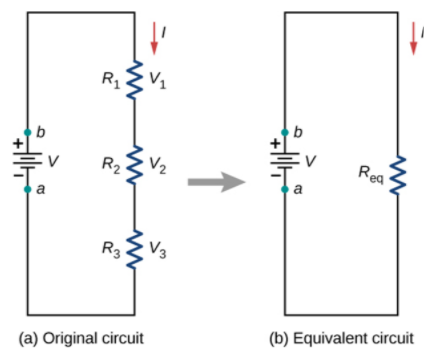
Series circuit me battery voltage V hai but each resistors ke across voltage V1,V2,V3 hoga jabki current I tino resistors me se same flow hoga. Now applying Ohm’s law to entire circuit we get
V=IR ……..(2)
On applying Ohm's law to the three resistors separately we have,
V1=IR1 …….(3)
V2=IR2 …….(4)
V3=IR3 …….(4)
From equation 1
IR=IR1+IR2+IR3..........(5)
Or, R=R1+R2+R3.......(6)
Yaha pr eq. 6 se hum conclude kr sakte hai ki jab resistors series me connected ho to equivalent resistance, individual resistances ka sum hoga jo individual resistance ki value se greater hoga.

1. For a series combination of resistors the current is same in every part of the circuit or same current flows through each resistor.
2. The total potential difference across a combination of resistors in series is equal to the sum of potential differences across the individual resistors.
3. When numbers of resistances are connected in series then their combined resistance is greater than the individual resistance.
Resistors in Parallel
Jab resistors ke ek ends ko ek taraf or sare resistors ke dusre ends ko dusri taraf connect kare to ye combination parallel combination kehlate hai. Niche diye gaye figure me resistors ke parallel combination ko show kiya gaya hai.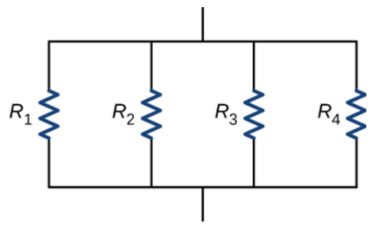
Jab hum resistors ke parallel connection ke across voltage supply V de to niche diye circuit me aap dekh sakte hai ki circuit me current I flow hoga jo resistors R1 and R2 ke branches me I1 and I2 divide ho jayega jabki each resistors ke across voltage V hi hoga. In parallel resistance ke equivalent resistance bhi hum calculate kr sakte hai.
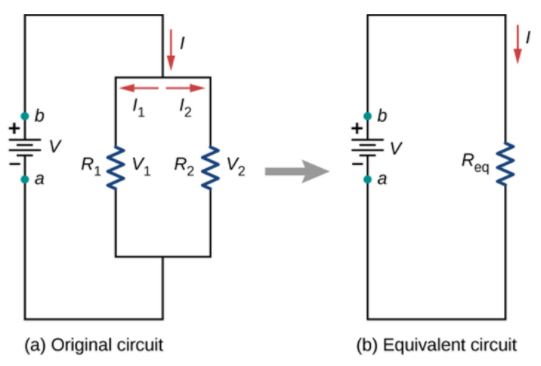
So,
I=I1+I2+I3..........(7)
Since potential difference across each resistors is V. Therefore, on applying Ohm's Law
V=I_1R1=I2R2=I3R3
Or, I1=VR1,I2=VR2,I3=VR3
Putting these values of current in equation 7 we have
I=VR1+VR2+VR3=V(1R1+1R2+1R3)
If R is the equivalent resistance of parallel combination of three resistors having resistances R1,R2andR3 then from Ohm's Law
V=IReq
or, I=VReq.........(8)
Comparing equation (7) and (8) we get
1Req=(1R1+1R2+1R3)..........(9)
Yaha pr eq. 9 se hum conclude kr sakte hai ki jab resistors parallel me connect ho to unke equivalent resistance ka reciprocal individual parallel resistance ke reciprocals ke sum ke equal hoga.

1. When a number of resistors are connected in parallel, then the potential difference across each resistance is equal to the voltage of the battery applied.
2. When a number of resistances are connected in parallel, then the sum of the currents flowing through all the resistances is equal to total current flowing in the circuit.
3. When numbers of resistances are connected in parallel then their combined resistance is less than the smallest individual resistance. This happens because the same current gets additional paths to flow resulting decrease in overall resistance of the circuit.
Combination of Series and Parallel Resistors
Resistors ke series or parallel combinations ko bhi aapas me combine kr sakte hai. Niche figure me aap combination of series and parallel ka ek example dekh sakte hai. Is figure me resistors R2 and R3 parallel me hai. Is parallel combination ke series me R1 resistor connected hai. Each resistor ke series me current measurement ke liye ammeter connect kiya gaya hai.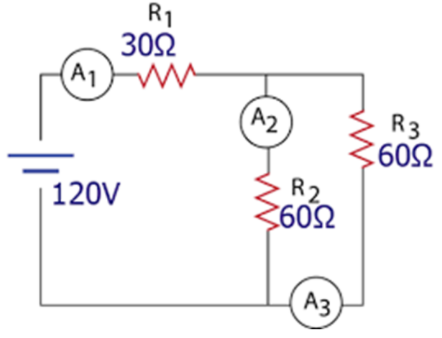
POINT 6
1. Resistors in Series :
When two or more resistances are connected end to end then they are said to be connected in series combination of resistors.
2. Resistors in parallel :
When two or more resistances are connected between the same two points they are said to be connected in parallel combination.
EXAMPLE 15
An electric lamp, whose resistance is 20 Ω, and a conductor of 4 Ω resistance are connected to a 6 V battery (Fig.). Calculate (a) the total resistance of the circuit, (b) the current through the circuit, and (c) the potential difference across the electric lamp and conductor.

The resistance of the electric lamp, R1=20Ω,
The resistance of the conductor connected in series, R2=4Ω
Then the total resistance in the circuit
R=R1+R2
Rs=20Ω+4Ω=24Ω
The total potential difference across the two terminals of the battery V = 6 V.
Now by Ohm’s law, the current through the circuit is given by
I=VRs
=6V24Ω
=0.25A
Applying Ohm’s law to the electric lamp and conductor separately, we get potential difference across the electric lamp,
V1=20Ω×0.25A=5V;
and, that across the conductor,
V2=4Ω×0.25A=1V.
Suppose that we like to replace the series combination of electric lamp and conductor by a single and equivalent resistor. Its resistance must be such that a potential difference of 6 V across the battery terminals will cause a current of 0.25 A in the circuit. The resistance R of this equivalent resistor would be R=VI=6V0.25A=24Ω
This is the total resistance of the series circuit; it is equal to the sum of the two resistances.
EXAMPLE 16
In Fig., R1=10Ω,R2=40Ω,R3=30Ω,R4=20Ω,R5=60Ω, and a 12 V battery is connected to the arrangement. Calculate (a) the total resistance in the circuit, and (b) the total current flowing in the circuit.
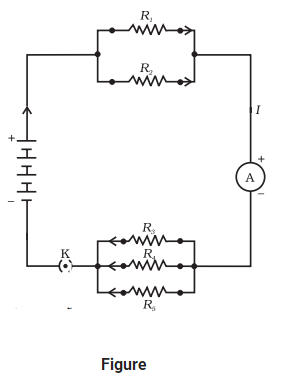
Suppose we replace the parallel resistors R1 and R2 by an equivalent resistor of resistance, R′. Similarly we replace the parallel resistors R3,R4 and R5 by an equivalent single resistor of resistance R″. Then, we have
1R'=110+140=540;
that is
R'=8Ω
Similarly,
1R''=130+120+160=660;
that is,
R''=10Ω
Thus, the total resistance,
R=R'+R''=18Ω
To calculate the current, we use Ohm’s law, and get
I=VR=12V18Ω=0.67A
EXAMPLE 17
In the circuit diagram given in Fig., suppose the resistors R1,R2 and R3 have the values 5Ω,10Ω,30Ω respectively, which have been connected to a battery of 12 V. Calculate (a) the current through each resistor, (b) the total current in the circuit, and (c) the total circuit resistance.
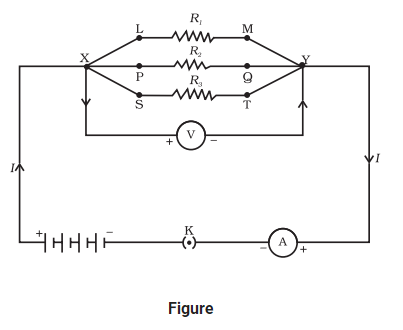
R1=5Ω,R2=10Ω, and R3=30Ω.
Potential difference across the battery, V = 12 V.
This is also the potential difference across each of the individual resistors; therefore, to calculate the current in the resistors, we use Ohm’s law.
The current I1, through R1=VR1
I1=12V5Ω=2.4A
The current I2, through R2=VR2
I2=12V10Ω=1.2A
The current I3, through R3=VR3
I3=12V30Ω=0.4A
The total current in the circuit,
I=I1+I2+I3
= (2.4 + 1.2 + 0.4) A
= 4 A
The total resistance Rp, is given by
1Rp=15+110+130=13
Thus, Rp=3Ω
EXAMPLE 18
Draw diagrams to show series and parallel combinations of resistors. State three salient features each of both the combinations. (CBSE 2015)
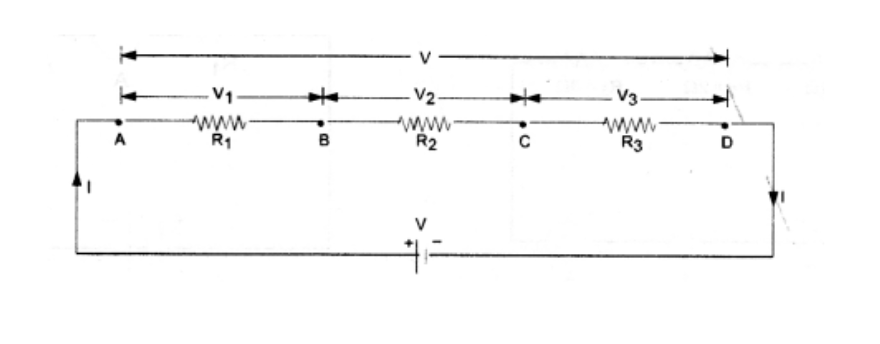

Salient features of series combination :
1. The net resistance of the combination is equal to the sum of the resistances of the individual resistor.
2. The current flowing through each resistor is the same.
3. The voltage applied across the series combination of resistors is equal to the sum of potential differences across the individual resistors.
Salient features of parallel combination :
1. The reciprocal of the net resistance of the combination is equal to the sum of the reciprocal of the resistances of the individual resistors.
2. Different amounts of current flows through each resistor.
3. The potential difference across each resistor is equal to the voltage applied across the combination.
EXAMPLE 19
A resistance of 6 ohms is connected in series with another resistance of 4 ohms. A potential difference of 20 volts is applied across the combination. Calculate the current through the circuit and potential difference across the 6 ohm resistance.
The first step in solving such problems based on current electricity is to draw a proper circuit diagram. For example, in this problem we have two resistances of 6 ohms and 4 ohms which are connected in series. So, first of all we have to draw these two resistances on paper as shown in Figure alongside. Now, a potential difference of 20 volts has been applied across this combination of resistances. So, we draw a cell or a battery of 20 volts and complete the circuit as shown in Figure alongside. Suppose the current flowing in the circuit is I amperes.
We will now find out the value of current I flowing through the circuit. To do this we should know the total resistance R of the circuit. Here we have two resistance of 6Ω and 4Ω connected in series. So,
Total resistance, R=R1+R4
R=6+4
R=10 ohms
Now, Total resistance, R=10 ohms
Potential difference, V=20 volts
and, Current in the circuit, I=? (To be calculated)
So, applying Ohm's law to the whole circuit, we get:
VI=R
So that, 20I=10
And, 10I=20
I=2010
So, Current, I=2 amperes (or 2A)
Thus, the current flowing through the circuit is 2 amperes. The second part of this problem is to find out the potential difference across the ends of the 6 ohms resistance. To do this we will have to apply Ohm's law to this resistance only. We know that the current flowing through the 6 ohm resistance will also be 2 amperes. Now,
Potential difference (across 6Ω resistance), V=? (To be calculated)
Current (through 6Ω resistance), I=2 amperes
And, Resistance, R=6 ohms
So, applying Ohm's law to the 6Ω resistance only, we get:
VI=R
or V2=6
So, Potential difference, V=12volts
Thus, the potential difference across the 6 ohm resistance is 12 volts.

EXAMPLE 20
If four resistance, each of value 1 ohm, are connected in series, what will be the resultant resistance?
Here we have four resistance each of 1 ohm, connected in series. These are shown in the Figure below.

Now, if we have four resistances R1,R1+R2+R3+R4
Here R1=1Ω,R2=1Ω,R3=1Ω,R4=1Ω
So, Resultant resistance, R=1+1+1+1
or R=4Ω
Thus, the resultant resistance is equal to 4 ohms.
We will now solve some problems by applying Ohm's law to the circuits having resistances in series.
HEATING EFFECT OF ELECTRIC CURRENT
Electric circuit me voltage supply dene se electric current flow hota hai. Ye electric current wire me present free electrons ke specific direction me flow ke karan hota hai. Ye electrons jab wire me flow hote hai tb aapas me ek dusre se takrate hai ya hit karte hai ya collide hote hai. Jab ye electrons collide hote hai to wire me ye heat produce karte hai. Is effect ko hi heating effect of electric current kahte hai.
Heating effect isliye hota hai kyuki electron ko move karne ke liye electrical energy ki jarurt hoti hai aur electrons ke aapas me collide hone ki wajah se electrical energy heat energy me transform hoti hai.
Electric current jis bhi conductor se flow hogi to us material ka kuchh na kuchh resistance (R) jo current ko resist karta hai or heat produce karta hai. Electric current kisi wire me jitne jyada time ke liye flow hoga utna jyada heat produce karega aur ager km time ke liye flow hua to km heat produce karega.
Is tarah se heat produce three terms pr depend kar raha hai- electric current, resistance of wire aur time. Ab hum wire me flow hone wale electric current ke karan produce heat ke liye expression derive karenge.
Consider a current I flowing through a resistor of resistance R. Let V be the potential difference across it as shown in below the figure .
Let t be the time during which charge Q flows. Now when charge Q moves against the potential difference V , then the amount of work is given by
W=Q×V...........(1)
Therefore the source must supply energy equal to VQ in time t. Hence power input to the circuit by the source is
P=VQt=VI..........(2)
The energy supplied to the circuit by the source in time t is P×t that is, VIt. This is the amount of energy dissipated in the resistor as heat energy. Thus for a steady current I flowing in the circuit for time t , the heat produced is given by
H=VIt.........(3)
Applying Ohm's law to above equation we get
H=I2Rt ………..(4)
This is known as Joule's Law of heating
Practical Applications of Heating Effect of Electric Current
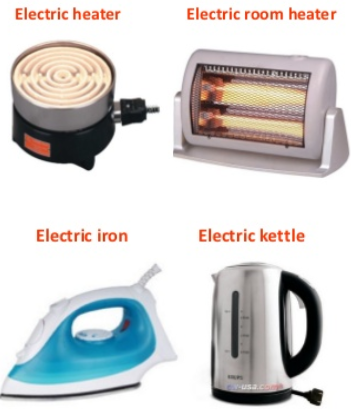
Heating devices aise material ke bane hote hai jinka resistance high ho, temperature bht jyada high hone pr bhi ye burn na ho aur coefficient of linear expansion (α) bht jyada high ho.
Coefficient of linear expansion ka mtlb temperature me change hone pr jab wire length me change hona.
Uper diye gaye figures me kuchh heating devices dikhaye gaye hai.
1. Electrical heating appliances jaise ki iron, room heater, water heater etc me heating effect of electric current ka use kiya jata hai.
2. Electric bulbs ya electric amps me light produce karne ke liye heating effect of electric current use hota hai.
3. Electric circuits me jab current rated value se jyada ho jaye to safety ke liye electric fuse use kiya jata hai. Fuse ke bare me hum next topic me detail me baat karenge.
4. Electric heater ya room heater and hair dryers me jo coils lage hote hai wo heating effect of electric current ke base pe work karte hai.
POINT 7
1. Heating Effect of Current :
When electric current passes through a high resistance wire, the electrons move and when they move, they collide with each other. When they collide, heat is produced. This is called the heating effect of current.
Heat produced depends upon the square of current, resistance and temperature.
H=I2Rt Joule
This is also known as Joule's Law of heating
EXAMPLE 21
100 J of heat are produced each second in a 4 Ω resistance. Find the potential difference across the resistor.
H = 100 J, R = 4 Ω, t = 1 s, V = ?
We have the current through the resistor as
I=√HRt
=√100J4Ω×1s
= 5 A
Thus the potential difference across the resistor, V is
V=IR
=5A×4Ω
=20V.
EXAMPLE 22
(a) Why is the tungsten used almost exclusively for filament of electric lamps ?
Or
Why is Tungsten used for the filament in electric bulbs ? (CBSE 2011, 2014, 2015)
(b) Why do copper or aluminium wires usually used for electricity transmission and distribution purposes ? (CBSE 2012, 2013)
Or
Copper and aluminium wires are usually employed for electricity transmission. Explain the reason.
(a) This is because
1. The melting point of tungsten is very high (about 3380°C) and
2. It does not oxidise (or burn) even at higher temperatures.
(b) The resistivities of copper and aluminium are very low, so electric current flows easily through them. Hence, copper and aluminium wires are usually used for electricity transmission and distribution purpose.
EXAMPLE 23
What is the commercial unit of electrical energy ? Express it in joules. (CBSE 2015)
Or
Define 1 kWh. How is this unit of energy related to 1 joule ? (CBSE 2011, 2015)
Or
Establish the relationship between 1 kWh and SI unit of energy (joule). (CBSE 2012, 2013, 2015)
Commercial unit of electrical energy is kWh. 1 kWh is the amount of electric energy consumed by 1000 W electric appliances when operated for 1 hour. 1 kWh = 1000 W x 3600 s = 1000 Js-1 x 3600 s = 3.6 x 106 J.
ELECTRIC POWER
Aapne class 9th me aapne ek term suna hoga Power. Jaha Power ka mtlb hota hata hai rate of doing work ya fr work done per unit time.
Power = workdone/time
Kyuki work karne ke liye energy ka use kiya jata hai isliye power ko hum energy consumed per unit time se bhi define kr sakte hai.
Electricity me circuit me electrons ko contiuously move karane ke liye work karte hai. Electricity me ye work voltage supply ke dwara kiya jata hai aur ye work electrical energy ke form me hota hai.
Islie electric power ko hum define kr sakte hai electrical work per unit time.
Electrical power = electrical work/time= electrical energy consumed/time
Electric power ka SI unit J/s hota hai jise watt (W) kahte hai.
1 Watt - jab 1 sec me 1 joule karna padhe ya 1 joule ki electrical energy consume ho to electric power 1 watt kahlata hai.
Power ka bigger units kilowatt and megawatt hota hai.
1kW=1000W=103W
1MW=1000kW=106W
Ab hum power ke equations ko derive karenge.
Hum jante hai ki electric potential work done per unit charge hota hai.
V=WQ
Is equation ko rearrange karke hum likh sakte hai.
W=V×Q
Ise hum power ke equation me rakhe to
P=V×Qt=VI
Yaha pr Q/t electric current hai.
Is prakar 1st equation of electric power
P=VI
Electric power ke next equation ko derive karne ke liye hum ohm’s law ke equations ka use karenge.
P=VI (V=IR)
P=I2×R
P=V2R
Niche figure me aap voltage current resistance or power ke biche sare relations dekh sakte hai.
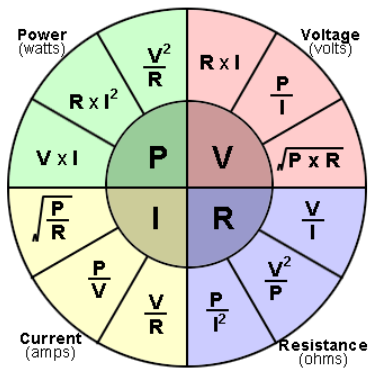
Electric Fuse
Kisi bhi electric device ki safety ke liye electric fuse ka use kiya jata hai. Two conditions hote hai jab kisi bhi electric device ko safety ki jarurt pd sakti hai.Jab bht sare appliance ko ek sath chalu kr de ek hi time pe to inko chalane ke liye large amount of electric current ki need hogi jiske karan bht jyada heat produce ho sakta hai even aag bhi lag sakti hai. Is condition ko overloading kahte hai.
Jab koi do conducting wire aapas me touch ho jate hai to current ki value normal value se bht jyada increase ho jati hai jiske karan bht jyada heat produce hone se aag lag sakti hai is condition ko shortcircuiting kahte hai.
In dono condition me jab large current ki wajah se aag lagne ka khatara hota hai jisse electric devices ko bachane ke liye hum fuse use karte hai.
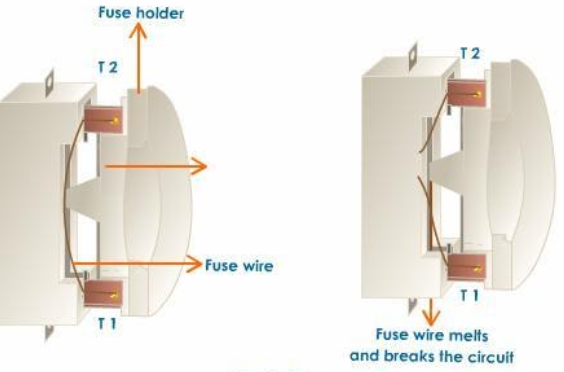
Fuse wire bht hi low melting point ka hota hai jo overloading ya shortcircuit ke karan produce hone wale large current se heat produce hone ke karan melt ho jati hai aur circuit ko break kr deti hai jisse large current electric appliances tk phuch bhi nahi pati aur safe ho jati hai. Isliye ye electric fuse wire kisi bhi electric circuit ki safety ke liye bht hi jyada important part hai.
POINT 8
1. Electric Power :
It is the rate of doing work. Rate of doing work or the rate of consumption of energy is known as electric power
Power = work done/ time taken=Wt
Or
The rate at which electric work is done or the rate at which electric energy is consumed is called electric power
SI unit of power is Watt which is denoted by letter W.
2. The Power of 1 Watt :
It is a rate of working of 1 Joule per second.
3. Electric Fuse :
It is a safety device that protects us from fire. The property of fuse wire is that it has very very low melting point.
EXAMPLE 24
(a) An electric bulb is connected to a 220 V generator. The current is 0.50 A. What is the power of the bulb?
(b) An electric iron consumes energy at a rate of 840 W when heating is at the maximum rate and 360 W when the heating is at the minimum. The voltage is 220 V. What are the current and the resistance in each case?
(a) P = VI
=220V×0.50A
= 110 J/s
= 110 W
(b) We know that the power input is P=VI
Thus the current I=PV
(a) When heating is at the maximum rate,
I=840W220V=3.82A;
and the resistance of the electric iron is
R=VI=220V3.82A=57.60Ω
(b) When heating is at the minimum rate,
I=360W220V=1.64A;
and the resistance of the electric iron is
R=VI=220V1.64A=134.15Ω.
EXAMPLE 25
An electric refrigerator rated 400 W operates 8 hour/day. What is the cost of the energy to operate it for 30 days at Rs 3.00 per kW h?
The total energy consumed by the refrigerator in 30 days would be
400 W × 8.0 hour/day × 30 days = 96000 W h = 96 kW h
Thus the cost of energy to operate the refrigerator for 30 days is
96 kW h × Rs 3.00 per kW h = Rs 288.00.
EXAMPLE 26
(a) What is meant by the statement that the rating of fuse in a circuit is 5A ?
(b) Name the material used for making the filament of a bulb.
(c) Define electric energy. (CBSE 2013, 2015)
(d) Define electric power.
(e) Name the physical quantity expressed as the product of potential difference and electric current.
(f) State SI unit of electric power.
(a) It means maximum current of 5A can pass through the fuse without melting it.
(b) Tungsten. on electric energy and electric power
(c) It is defined as the work done by a source of electricity to maintain electric current in an electrical circuit.
(d) It is defined as the amount of electric energy consumed in an electric circuit per unit time.
(e) Electric power.
(f) Volt x ampere (or Watt).
EXAMPLE 27
Define electric power. A device of resistance R is connected across a source of V voltage and draws a current I. Derive an expression for power in terms of voltage and resistance.
Electric power is defined as the amount of electric work or electric energy per unit time.
If W be the amount of electric energy consumed in a circuit in t seconds, then the electric power is given by
P=Wt ….(1)
Since W= electric energy =VIt
therefore P=VItt
or P=VI ....(2)
Thus, electric power is defined as the product of potential difference applied across the circuit and current flowing through it.
According to ohm’s law
V=IR
therefore from eq. (2),
P=I2R
Also I=VR
therefore from eq. (2),
P=V2R
Thus, P=VI=I2R=V2R
Units of Power :
SI unit of power is watt (or W)
We know,
therefore 1watt = 1volt × 1 ampere =1 VA.
KEY FORMULA
* q=ne
where q= charge
n= integer number
e= electron =−1.6×10−19C
* Potential difference=work donequantity of charge transferred
* Electric Current I=Qt
* Electric Resistance R=(ρ)lA
* Resistance in series R=R1+R2+R3
* Resistance in parallel 1R=1R1+1R2+1R3
* Heating effect of electric current H=I2Rt
* Electric Power P=work dinetime
⇒P=VI
⇒P=I2R
⇒P=V/R
SUMMARY
1. A stream of electrons moving through a conductor constitutes an electric current. Conventionally, the direction of current is taken opposite to the direction of flow of electrons.
2. The SI unit of electric current is ampere.
3. To set the electrons in motion in an electric circuit, we use a cell or a battery. A cell generates a potential difference across its terminals. It is measured in volts (V).
4. Resistance is a property that resists the flow of electrons in a conductor. It controls the magnitude of the current. The SI unit of resistance is ohm (Ω).
5. Ohm’s law: The potential difference across the ends of a resistor is directly proportional to the current through it, provided its temperature remains the same.
6. The resistance of a conductor depends directly on its length, inversely on its area of cross-section, and also on the material of the conductor.
7. The equivalent resistance of several resistors in series is equal to the sum of their individual resistances.
8. A set of resistors connected in parallel has an equivalent resistance Rp given by 1Rp=1R1+1R2+1R3+.....
9. The electrical energy dissipated in a resistor is given by W=V×I×t
10. The unit of power is watt (W). One watt of power is consumed when 1 A of current flows at a potential difference of 1 V.
11. The commercial unit of electrical energy is kilowatt hour (kWh). 1kWh=3,600,000J=3.6×106J.
